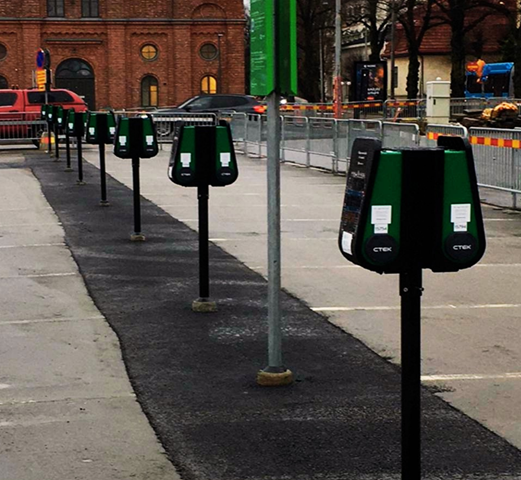
CTEK Back to Back 4 socket charging
With ownership of electric vehicles (EVs) continuing to grow, a YouGov survey conducted on behalf of vehicle charging specialists CTEK has revealed that more drivers are now looking to charge their EVs in public, rather than at home.1
The survey reveals that, while 68% of EV drivers still prefer to charge their vehicles at home, more than a third (37%) of EV drivers are now using public chargers, 12% are charging at work and 9% at petrol stations.
Cecilia Routledge, CTEK’s Global Head of E-Mobility, said: “With previous estimates of up to 90% of EV charging taking place at home, this is a fairly significant shift, and we can expect the need for public charging to intensify as coronavirus restrictions in the UK continue to be lifted. Not only that, permanent changes to working patterns and more home working are likely to result in people visiting their workplace less often, so EV owners with nowhere to install a home charger will increasingly need to rely on public chargers and those at destinations like shopping centres and supermarkets.”
The low use of petrol station charging also indicates that drivers prefer to combine charging with a longer stop, perhaps to do a bit of shopping, have a coffee or a bite to eat. But the survey reveals that availability and reliability of chargers, or not knowing the location of them, remains a concern for existing EV drivers (30%) and those considering an EV (39%). Charger reliability was also one of the two main concerns raised by local authority representatives attending the Everything EV Summit in April, with the other key concern raised by local authorities being the availability of power from the grid.
CTEK has the following advice and guidance for local authorities looking to install or expand public EV charging networks.
- AC/DC. CTEK’s research reveals that the typical charge at a public chargepoint is around 10 kWh, and that vehicles are plugged in for approximately 3 hours, with drivers generally topping up their battery rather than charging from empty. CTEK therefore recommends that, in public parking spots where drivers are likely to stop for longer and are in less of a rush, AC (alternating current) chargers that deliver slow to medium charge are generally more than adequate, and that rapid charge DC (direct current) chargers, that are expensive to install and draw a lot of power from the grid, are rarely needed. In Sweden’s second biggest city Gothenburg for example, CTEK has installed a network of 1,500 AC chargers (800 x 22 kW chargers and 700 x 3.7 kW chargers), both on and off street, but there are only 20 public DC chargers in the whole of the city.
- Power balance. If availability of power is a concern, dynamic load balancing on EV networks reduces the need for grid expansion and connection costs by optimising and distributing available power between buildings and across all operational chargers. This ensures vehicles are all charged as quickly as possible, while preventing overload on the grid and maintaining power to buildings and anything else drawing power from it (e.g. street lights, traffic lights). Without load balancing, increased demand from EV chargers could cause main fuses to blow or trip, due to the demand for power being more than what’s available.
- Reliability. Robust chargepoints with high quality components will result in less downtime, less need for ongoing maintenance and replacement, and less frustration for drivers. For outside units, a durable external casing is recommended to deter vandalism and protect from the weather. CTEK’s ‘Chargestorm Connected 2’ chargers are built using robust, top quality components and materials for maximum reliability and reduced maintenance, with a durable IK10 rated metal casing that’s built to withstand a Swedish Winter!
- Doubling up. For local authorities looking for a cost-effective way to install or expand their charging networks, CTEK offers a dual socket ‘Chargestorm Connected 2’ charger, where two vehicles can plug in and charge at the same time. This can halve the number of physical units that need to be installed, and at considerably reduced cost. These chargers can be either wall or pole mounted, and CTEK also offers a 4 socket ‘back to back’ solution, where two dual socket chargers can be sited on a single pole.
This innovative, space saving charging solution is ideal for small parking areas, particularly in double row ‘bay’ parking situations, where vehicle are parked ‘front to front’. For larger installations, like major public car parks, the sets of four chargers can be linked together in networks of up to 500 individual chargers on 125 poles.
- Fit for the future. Make sure your charging network allows for easy expansion as demand inevitably grows, and that it is OCPP (Open Charge Point Protocol) compliant, allowing seamless integration with other manufacturer’s equipment, including pay points.
- Why smart charging pays. The Government has consulted on proposals that all new UK EV chargers must have smart charging included, which would allow drivers to plug in and set their vehicles to charge during off-peak periods when energy demand is low. But there are other advantages too – smart charging also gives drivers the flexibility to select a specific charging profile to suit their needs, for example the speed of charge and for how long that charge is delivered. And paypoint equipment, which can be seamlessly integrated with CTEK’s chargers, can apply differential prices for different charging profiles, for example fast/slow charging or priority charging. Vehicle owners currently identify themselves with a tag or mobile app but, in future (with the introduction of IS0 15118 standards for EVs), vehicles will be able to identify themselves just by plugging in to the charger!
- Government In line with the Government’s stated vision to have one of the best electric vehicle infrastructure networks in the world2, their 10 point plan for a green industrial revolution published in November 2020 has committed £1.3 billion to accelerate infrastructure roll out. As part of this £20m of funding has been committed to On-Street Residential Grant Scheme for 2021/22, to encourage local authorities to install on-street charging points.

Cecilia Routledge, CTEK’s Global Head of E-Mobility
The scheme gives local authorities access to grant funding of up to 75% of the capital cost of procuring and installing on-street EV chargepoint infrastructure to meet residential needs. The scheme is primarily focused on the installation of chargepoints in on-street locations; however, OZEV recognises the potential pressures that may be faced by local authorities when allocating parking spaces for EVs on residential streets. Therefore, applications for chargepoints situated in car parks owned by the local authority will be considered provided they meet the objectives of the scheme – meaning that the car park is suitably located in or near a residential area, and provides an option for local residents looking to charge their car both during the day and overnight.
“The future of sustainable transport lies with rechargeable vehicles, and local authorities have a key role to play in that,” said Cecilia. “The development of robust public charging networks will not only support existing EV drivers, but will also encourage further EV adoption and a greener, cleaner future for us all, as we head along the road to zero.”
About CTEK
Established in Sweden, CTEK is the leading global brand in vehicle charging solutions. CTEK takes pride in its unique culture, based on a passion for innovation and a deep commitment to supporting the transition to a greener mobility, by adhering to industry leading ESG standards.
In Sweden, CTEK has installed more than 12,000 public EV chargers, working with many public companies including Stockholm Parking, who are targeting 4,000 public chargers in the city by 2022.
CTEK’s E-mobility solutions range from individual EV chargers to larger corporate and commercial installations with multiple charging stations, that require load balancing and integrate seamlessly with monitoring and payment equipment.
For more information, visit www.ctek.com







Recent Comments